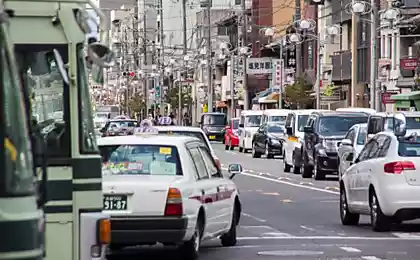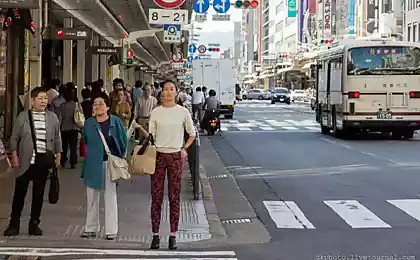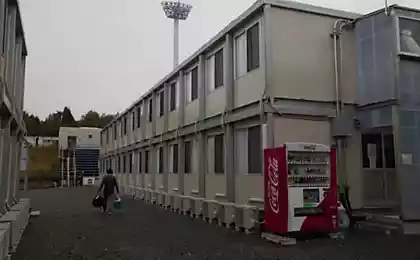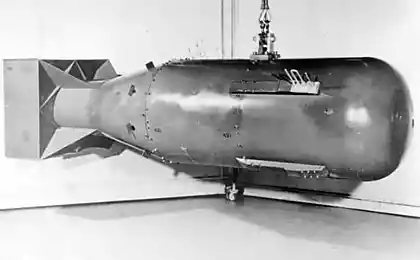543
Kyoto: a city that hides

Express "Haruka" went softly, almost silently. Low houses, pushing each other, standing so close to the railway, which seemed to look in the window of the car. Was not habitual to the Russian eye the vast forests and fields, on every foreseeable piece of land was a seal of civilization. But my heart was warmed with the upcoming long-awaited meeting with Kyoto city, which seemed to me to be the most zealous guardian of the "ancient legends". Imagine my disappointment when, some time later, the train arrived at the destination — on-the-art space station called "Kyoto EKI" Kyoto station. It's a huge, incomprehensible form building with cafe, restaurants, various shops, offices and hotels sparkled and shimmered with all its intricate designs, like a giant fish that just washed up on shore. Behind the station building is also stretched quite a modern area with hotels, shops and multistory tower. And just standing on the roof of the station, where there is an observation site, can be seen in some places flashing curved tile roofs and smooth contours of the mountains. Because of the high humidity so typical of Kyoto, the mountains were shrouded in a light mist and therefore seemed to some unrealistic, descended from ancient Chinese scrolls.
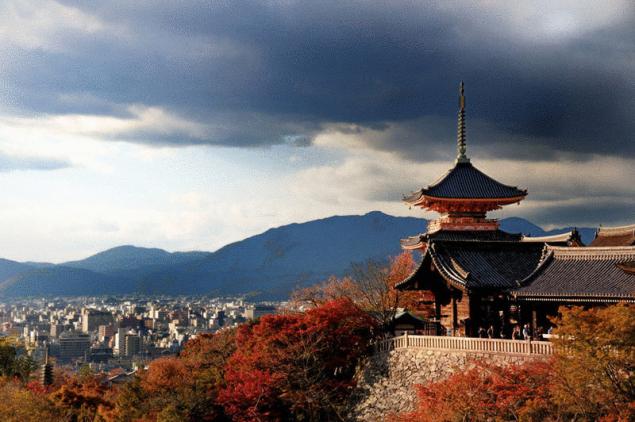
First impressions tells us that the true beauty of the ancient capital, about which so much is written and spoken, does not lie on the surface. I remembered the Yukio Mishima novel "the Golden Temple", the hero whose lifelong dream to see the Kinkakuji — the famous Golden Pavilion in the North-Western part of Kyoto, but when she saw, she experienced a lot of disappointment and thinking that he hides from his own beautiful image. "Perhaps the best, in order to protect themselves, must hide, to deceive the human eye?" it was about a young man and decided I needed to get close to him, to consider all the details, "to get to the core Beautiful." As the hero of the novel, it became apparent to me: to discover the real Kyoto, it takes effort. You will need patience, a map, and possibly a bike — bikes are not less than machines.
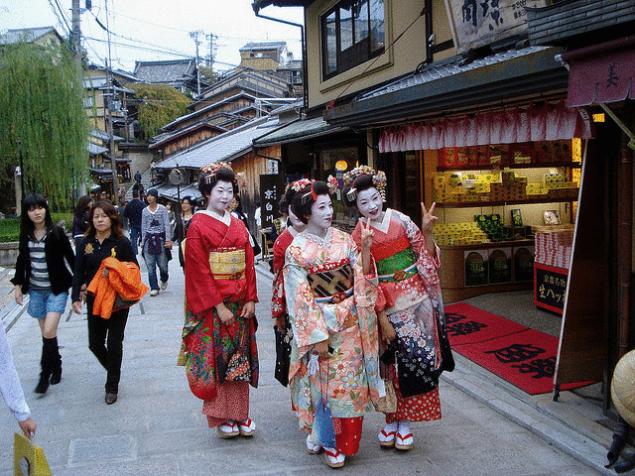
A popular place for tourists in Kyoto is gion, the old quarter in the city centre, where here and there glimpses of the bridges over a narrow canal, small colorful restaurants and tearooms, scurrying rickshaws with black carts, and if you're lucky, you can see and hurrying out of the geisha or Maiko-San dressed in a kimono. You can also go in the Holy of holies of the former capital of the Imperial Palace in the Northern part of the city or visit the famous samurai the possession of the Tokugawa family — to Nijo castle, a real medieval castle with fortified walls, watchtowers and moats filled with water. And best of all just turn your bike for the first house and go at random through the narrow streets, clinging to each other. Then, despite all the assurances of the guides, which say that Kyoto is impossible to get lost because, according to the old Chinese tradition, it is divided into squares strictly symmetrical streets, I assure you, you will certainly get lost. And lost, you will definitely discover another Kyoto is the city where all roads lead to temples, of which there are thousands.
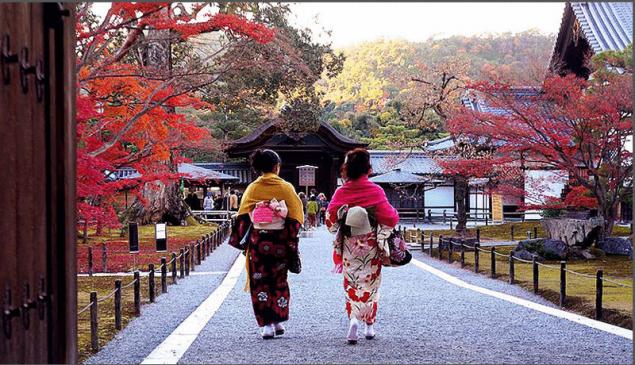
This is a huge complex of Buddhist monasteries and the temple of Camellias, not even marked on the map, and sometimes a small altar in the middle of the street with a stone deity jizo, dressed in the red bertocco and the Cape — so touchingly childish citizens care, to time and weather have erased the outlines of their patrons. To get around all the Holy places of Kyoto, not enough, perhaps, and a few years of life. But despite this huge number of temples, monasteries and shrines, each of them has its own unique "face", is my little secret, secret, which can be open just after entering the gate. And there you are waiting for some tree shapes, little Buddha hiding behind a Bush, azaleas, incomprehensible stone garden, the giant red carp in a tiny pond or, as in the temple of Rokkakudo, two white Swan in the source, where, as legend has it, bathed after a long journey, the Prince Shotoku Taishi. And all of these places there is another amazing feature: if you enter through the massive gates of a Buddhist temple or through a red torii (gate to a Shinto Shrine), everywhere here reigns a kind of boundless, untouched by the sounds of the city quiet. And this silence can't break nothing but nature, which sometimes breaks in here frantic singing of cicadas, the rustle of the wind in the pine branches, or two claps of someone's hands, speaking to Sky: "I am here!"
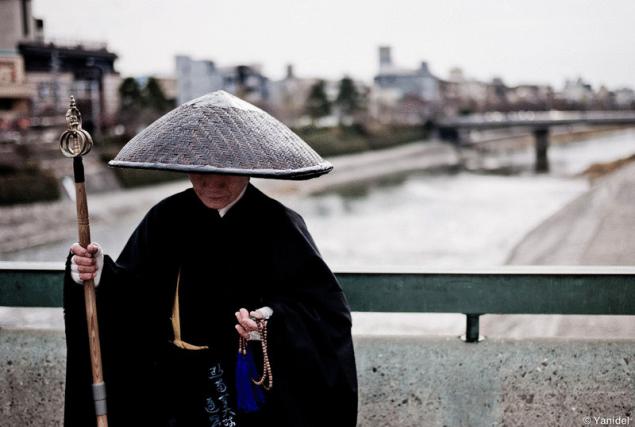
Traveling the numerous temples of modern Kyoto, it is difficult to believe the fact that when, more than 12 centuries ago, who ascended the throne Emperor Kammu decided to move the capital from the prosperous town of Nara it is because of the too strong influence on the Imperial court of large Buddhist monasteries. Rather, the first for the construction of a new Palace, it was determined the town of Nagaoka, where immediately began work. But then, according to Chronicles, the Imperial family was hit by a series of misfortunes. Probably sensitive to the signs and predictions, the Emperor was not more to tempt fate and soon identified a new location for the future capital, which gave the name Heian-Kyo is "Capital of Peace" (the current name "Kyoto" means "capital"). The city was built by all the canons of Chinese urban development, imitating the General plan of the capital of the sui dynasty — Chang'an. From the North, East and West, as was supposed, it was surrounded by mountains. One of them — MT (translation — "Such Wisdom"), the most mysterious and mystical, which is considered to be a Kyoto Fuji, was built Buddhist temple, Comportado. The main attraction of the temple is a figure of Buddha-healer Yakushi Nyorai, which, according to Buddhist legend, 1200 years ago kindled "endless Fire of Dharma". To this day in the lampstands of the temple and day and night firing. Comportado, and then a huge monastery complex that soon arose around it, were designed to protect Heian from the evil forces coming, according to Chinese geomancy, from the North-East. So, as growth and prosperity, and despite Imperial bans, the young capital is somehow miraculously again and again overgrown temples and monasteries, creating a bizarre mosaic of space and time called Heian. Indeed, in the history of Japan Heian is not only a place, not only a city with strongly lined streets, wooden buildings and tiled roofs, is a special time that gave name to an era.
In historical reference to the Heian period allotted between the end of VIII until mid XI century — the reign of the aristocracy and the flourishing of culture. Time, filled with special grace and refined manners, the search for beauty in everything is fleeting, fragile and elusive. Time when the whole court nobility enthusiastically indulged in pursuits of calligraphy, painting, poetry and a compilation of flavors. One court lady named Murasaki Shikibu in his leisure hours, as if effortlessly, he wrote the story later made it famous for centuries — the famous "Genji Monogatari", "the Tale of Genji", which is still considered to be unsurpassed masterpiece of Japanese literature. To understand how and what living at that time, the Imperial court, there is nothing better than to look at the pages of this work:
"It was the middle of the Third moon, the days were cloudless, and serene people — the most suitable time for quiet, elegant entertainment. Besides, in the near future is not planned any ceremonies, so both ladies had enough leisure time to paint..."
"On excellent Chinese paper was great, but even more amazing, truly incomparable thought Prince calligraphy in a relaxed Jenskom" style, perfectly matching with the Korean paper, thick and soft, delicate shades. The Prince felt his eyes boil with tears, as if hastening to unite with the erosion of the carcass. It was impossible to take your eyes off these beautiful lines..."
Remembering that time, the Japanese say: "Mono-no avare", which translates as "the charm of things". But it's not so much the things themselves, and in particular the ability of people to see these things and phenomena and deeply empathize with them, whether falling cherry blossoms just blooming Wisteria or someone gracefully written lines. Heian era through the thickness of centuries trying to convey to us this amazing vision of things, that perfect the form of culture, which, as said Rabindranath Tagore, "developed in humans, such quality of vision, when you see the truth in beauty and beauty in truth."
Perhaps another striking symbol of that era extant, be called the temple Bedoin on the banks of the Uji river and its famous Phoenix Hall. It is amazing in its elegance and symmetry of the building, devoid of any ostentatious pomp and pathos, is an example of the finest artistic taste. Built at the end of the Heian era's most influential aristocratic Fujiwara clan, it seemed to have absorbed the spirit of the time, its aspirations and dreams of a distant "Pure Land", the sacred Buddhist Paradise, where there is harmony and perfection, where there is ever reviving Phoenix, and the bodhisattva perform your duty, playing music and dancing in the clouds. Looking today at is darkened by time and adversity architectural creation, involuntarily comparing him with the big sad bird, crouching near the water. Here she spread their graceful wings, ready to fly, but never flew, more admiring his own reflection.
As sad Bedoin in Uji, the Capital of Peace has seen a lot in his lifetime. Despite the loud call in her behalf she has had enough of Palace intrigue, bloody wars, fires and destruction. But every time she, like the mythical bird was again reborn from the ashes. City changed their shape, the time passed... And yet, whatever may be said about the time, it never disappeared. Oddly enough, but it was the temples and monasteries, which once ran the Emperor Kammu, were the most faithful custodians of these tracks. It is here, as hundreds of years ago to attend the holidays with an amazing time for our names: the festival of Flowers Hagi or Plum blossoms, Fireflies festival, the festival of Combs or festival Green Leaves. These festivals-"Matsuri", large and small, in Kyoto a great many. There are those, such as the Gion festival, which attracts audiences from different parts of the country. On this hot July day on the Central streets of Kyoto citizens are carrying 32 palanquin, richly adorned with expensive rugs and tapestries imported from all over the world. And the first such procession was held in the year 869, when the capital was gripped by an epidemic of plague. Then, on the orders of the Emperor from the main Shrine, Yasaka Shrine (present — gion), were rendered sacred palanquins, which, according to legend, was inhabited by the divine spirit very brother/th sun goddess Amaterasu. They say that this spirit had some special power, able to overcome even the plague. And the result of the terrible disease receded. Since then, the residents of Kyoto celebrate this event with great generosity and luxury. In such celebrations, as many centuries ago, the priests make offerings to the gods, plays old music, performed ritual dances. Time stands still for a moment and again starts forward to make another round.
Kyoto is able to preserve and appreciate the time, steadily following the usual ritual of transition from one season to another. About the seasonality in Kyoto not only made to constantly talk about it is usually to feel and live from day to day. Cold winters and stifling hot summers, the eternal topics of conversation. To them as if already long to cook so that it's easier to survive. But wait and look forward to in Japan early spring and late autumn, the time in Europe generally tried quickly and quietly to slip through. These two brief moments in Kyoto are lived with special intensity and splendor worthy of the Heian era. The city has not yet managed to shake off the last signs of the cold, and countless gardens are already covered with plum flowers. In April, Kyoto is transformed. Thousands of pilgrims from all over the world flock here to witness a small miracle — flowering Japanese cherry. "Hanami" — cherry blossom viewing — becoming the event a truly national scale. It's hard to find a single flowering tree, wherever they camped for the night some noisy company. Late autumn ancient capital covers the new fever called "Momiji" to admire the red maples. Tourists from all over the country and the world fill the most famous places in Kyoto. Large monasteries such as Daitokuji and Nanzenji, open for viewing my little treasures — the famous programove gardens. But the most crowded at this period, probably, becomes the Arashiyama district in the past a popular place for the Imperial court. Here all the surrounding hills, bordering the river, passed such a variety of colors, such power and perfection of the autumn palette that catches the breath, and the strange sensitivity of Prince Genji seems quite natural and appropriate. But even more strong feelings when you suddenly can look into some small Church, hidden from curious tourists deep in the streets. One of a spreading maple, a few crimson leaves fall off the branches, circling slowly, fall on the black gravel, forming an intricate brocade pattern... Or when it grows dark, and the moon through the red leaves reflected in the mirrored surface of the pond... What seem to be simple and clear then the lines written by a poet thousands of years ago:
Once the wind blow,
and clean surface of the carpet
scarlet maple leaves
even those that have not fallen down,
in depth look reflection... posted
Author: Elena
P. S. And remember, just changing your mind — together we change the world! ©
Source: www.newacropolis.ru/magazines/5_2003/Kioto_gorod_kotor_pr/

